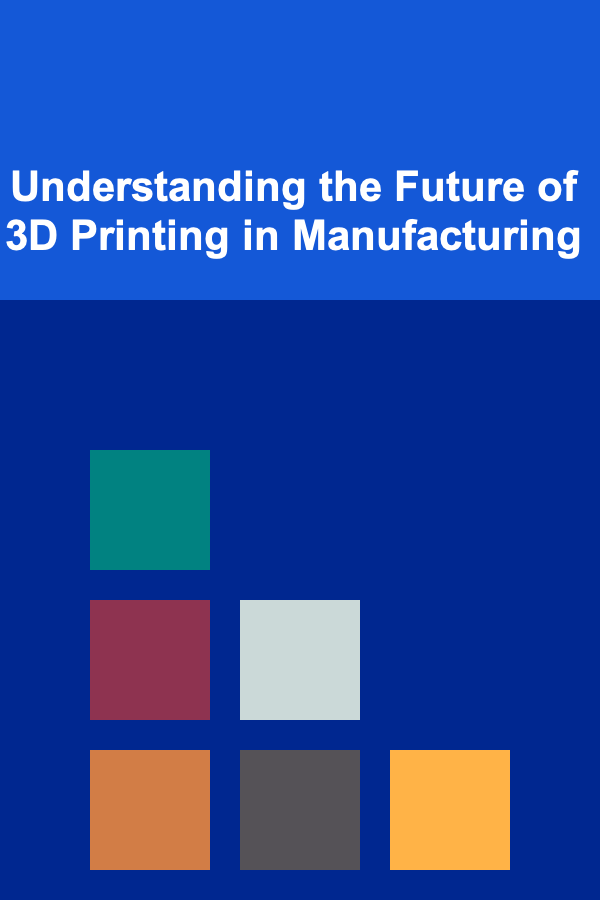
Understanding the Future of 3D Printing in Manufacturing
ebook include PDF & Audio bundle (Micro Guide)
$12.99$10.99
Limited Time Offer! Order within the next:

3D printing, also known as additive manufacturing (AM), has evolved from a prototyping tool to a transformative force in the manufacturing industry. Understanding its future requires delving into current trends, technological advancements, challenges, and the broader economic and societal context. This article will explore these facets to provide a comprehensive perspective on how 3D printing is poised to reshape manufacturing landscapes.
The Current State of 3D Printing in Manufacturing
While hype surrounding 3D printing has fluctuated, the technology has steadily matured. It's no longer just about rapid prototyping; it's about creating functional parts, tooling, and even end-use products in various industries. Several key trends define the current landscape:
- Adoption in Aerospace and Automotive: These industries are leading adopters, utilizing 3D printing for lightweighting components, creating complex geometries impossible with traditional methods, and accelerating design iterations. Examples include GE Aviation's LEAP engine fuel nozzles and various custom automotive parts.
- Growth in Medical and Dental Applications: Patient-specific implants, surgical guides, and dental prosthetics are increasingly manufactured using 3D printing, offering customized solutions and improved patient outcomes. Bioprinting, while still nascent, holds enormous potential for creating tissues and organs.
- Rise of Mass Customization: 3D printing enables mass customization at scale, allowing manufacturers to tailor products to individual customer needs without significant cost increases. This is particularly relevant in areas like eyewear, footwear, and personalized medical devices.
- Development of New Materials: The range of materials compatible with 3D printing is expanding rapidly, including high-performance polymers, metals, ceramics, and composites. This material diversification is crucial for broadening the application scope of the technology.
- Advancements in Printing Technologies: Various printing technologies, such as Fused Deposition Modeling (FDM), Stereolithography (SLA), Selective Laser Sintering (SLS), and Direct Metal Laser Sintering (DMLS), cater to different material types, precision requirements, and production volumes. Each technology has its strengths and weaknesses, influencing its suitability for specific applications.
Key Technological Advancements Shaping the Future
The future of 3D printing in manufacturing hinges on continued innovation across several technological fronts:
1. Faster Printing Speeds and Increased Build Volumes
One of the major limitations of 3D printing has been its relatively slow printing speeds and restricted build volumes compared to traditional manufacturing processes. Addressing this is critical for broader adoption in mass production. Advancements in this area include:
- High-Speed Sintering (HSS): HSS uses infrared lamps instead of lasers to sinter powder materials, enabling faster printing speeds and larger build areas.
- Volumetric 3D Printing: This emerging technology uses light to solidify an entire volume of resin simultaneously, potentially drastically reducing printing times. However, it's still in early stages of development.
- Multi-Jet Fusion (MJF): HP's MJF technology uses multiple print heads to deposit fusing and detailing agents across the powder bed, resulting in faster printing speeds and improved part properties.
- Large-Format 3D Printing: Companies are developing printers with significantly larger build volumes, enabling the production of larger parts and assemblies. This is particularly relevant for industries like aerospace and construction.
2. Multi-Material Printing and Functional Gradient Materials
The ability to print with multiple materials simultaneously opens up new possibilities for creating complex and functional parts with tailored properties. Functional gradient materials, where material properties vary throughout the part, can be achieved through multi-material printing. This enables:
- Integrated Functionality: Combining different materials within a single part to achieve specific functionalities, such as electrical conductivity, thermal insulation, or vibration damping.
- Optimized Performance: Tailoring material properties to specific stress or load requirements, resulting in lighter and more efficient parts.
- Bio-Mimicry: Creating parts that mimic the structure and properties of biological materials, such as bones or tissues.
3. Automation and Integration with Industry 4.0
Integrating 3D printing into the broader Industry 4.0 ecosystem is crucial for realizing its full potential. This involves automating various stages of the 3D printing process and connecting printers to other manufacturing systems. Key aspects include:
- Automated Build Plate Removal and Part Handling: Robots and automated systems can remove finished parts from the build plate and transport them to post-processing stations, reducing manual labor and increasing efficiency.
- Closed-Loop Feedback Control: Sensors and feedback systems monitor the printing process in real-time, allowing for adjustments to parameters to ensure consistent part quality.
- Integration with CAD/CAM Software: Seamless integration with CAD/CAM software allows for direct transfer of designs to the 3D printer, streamlining the design-to-manufacturing workflow.
- Data Analytics and Predictive Maintenance: Analyzing data from 3D printers can identify potential problems and optimize printing parameters, reducing downtime and improving part quality.
4. Artificial Intelligence (AI) and Machine Learning (ML)
AI and ML are playing an increasingly important role in optimizing 3D printing processes and improving part quality. Applications include:
- Design Optimization: AI algorithms can optimize part designs for 3D printing, taking into account factors such as material properties, stress requirements, and printing parameters. Generative design, powered by AI, can create innovative and efficient designs that would be difficult to conceive manually.
- Process Monitoring and Control: ML algorithms can analyze sensor data from 3D printers to detect anomalies and predict potential failures, allowing for proactive interventions.
- Material Development: AI can accelerate the discovery and development of new 3D printing materials by predicting material properties and optimizing material formulations.
- Quality Control: AI-powered vision systems can inspect 3D printed parts for defects and ensure that they meet quality standards.
5. Advancements in Post-Processing Techniques
Post-processing is an essential step in the 3D printing workflow, often involving removing supports, cleaning parts, and surface finishing. Automating and improving post-processing techniques is crucial for increasing efficiency and reducing costs. Examples include:
- Automated Support Removal: Robots and automated systems can remove supports from 3D printed parts more efficiently than manual methods.
- Chemical Smoothing: Chemical treatments can smooth the surface of 3D printed parts, improving their aesthetic appearance and mechanical properties.
- Surface Coating and Painting: Automated coating and painting systems can apply protective coatings or decorative finishes to 3D printed parts.
- Hot Isostatic Pressing (HIP): HIP is a process that uses high pressure and temperature to improve the density and mechanical properties of metal 3D printed parts.
Impact on Different Manufacturing Sectors
The future of 3D printing will have a varying impact on different manufacturing sectors, depending on their specific needs and requirements. Here's a look at some key sectors:
1. Aerospace
Aerospace is one of the most advanced adopters of 3D printing. Key applications include:
- Lightweighting Components: 3D printing enables the creation of complex geometries that are lighter than traditionally manufactured parts, reducing fuel consumption and improving aircraft performance.
- Customization and On-Demand Manufacturing: 3D printing allows for the creation of customized parts and spares on-demand, reducing lead times and inventory costs.
- Engine Components: 3D printing is used to manufacture complex engine components, such as fuel nozzles and turbine blades, with improved performance and durability.
The future will see further adoption of 3D printing in aerospace for larger structural components, more complex engine designs, and the integration of sensors and electronics within 3D printed parts.
2. Automotive
The automotive industry is using 3D printing for:
- Prototyping and Tooling: 3D printing is used to create prototypes and tooling for automotive parts, accelerating the design and development process.
- Customization and Personalization: 3D printing enables the creation of customized automotive parts and accessories, allowing for personalization and differentiation.
- Low-Volume Production: 3D printing is used to manufacture low-volume production parts, such as specialty components and replacement parts for classic cars.
In the future, 3D printing will play a larger role in the mass production of automotive parts, particularly for electric vehicles, where lightweighting and customization are key priorities. The technology will also facilitate the creation of complex, integrated systems within vehicles.
3. Medical and Dental
3D printing is revolutionizing the medical and dental fields through:
- Patient-Specific Implants and Prosthetics: 3D printing enables the creation of customized implants and prosthetics that are tailored to the individual patient's anatomy.
- Surgical Guides and Planning: 3D printed surgical guides and models help surgeons plan and execute complex procedures with greater precision.
- Drug Delivery Systems: 3D printing can be used to create customized drug delivery systems that release medication at a controlled rate.
- Bioprinting: Although still in its early stages, bioprinting holds the potential to create tissues and organs for transplantation.
The future will see wider adoption of 3D printing in medical and dental for more complex implants, personalized medications, and potentially, functional tissues and organs. Bioprinting is a long-term, high-potential area.
4. Consumer Goods
3D printing is impacting the consumer goods sector through:
- Mass Customization: 3D printing enables the creation of customized products that are tailored to the individual customer's preferences.
- On-Demand Manufacturing: 3D printing allows for the manufacturing of products on-demand, reducing inventory costs and waste.
- Personalized Products: 3D printing facilitates the creation of personalized products, such as eyewear, footwear, and jewelry.
In the future, 3D printing will play a larger role in the mass customization of consumer goods, allowing for greater personalization and product differentiation. We may see "micro-factories" emerge, offering customized products on a local scale.
Challenges and Obstacles to Wider Adoption
Despite its potential, 3D printing still faces several challenges that need to be addressed for wider adoption in manufacturing:
- Cost: The cost of 3D printing equipment and materials can be high, particularly for metal and ceramic printing. The cost per part can also be higher than traditional manufacturing methods, especially for high-volume production.
- Speed: 3D printing speeds are still relatively slow compared to traditional manufacturing processes, limiting its suitability for high-volume production.
- Materials: The range of materials compatible with 3D printing is still limited compared to traditional manufacturing methods. Furthermore, the properties of 3D printed materials can sometimes be inferior to those of traditionally manufactured materials.
- Skills Gap: There is a shortage of skilled professionals who can design, operate, and maintain 3D printing equipment.
- Standardization: A lack of standardization in 3D printing processes and materials can hinder its adoption and make it difficult to compare different 3D printing technologies.
- Scalability: Scaling up 3D printing production can be challenging, particularly for complex parts and high-volume applications.
- Intellectual Property Protection: Protecting intellectual property can be challenging in the 3D printing environment, as designs can be easily copied and shared.
The Economic and Societal Impact
The widespread adoption of 3D printing will have significant economic and societal impacts:
- Reshoring of Manufacturing: 3D printing could enable companies to reshore manufacturing operations to developed countries, reducing reliance on overseas suppliers.
- Decentralized Manufacturing: 3D printing could facilitate the decentralization of manufacturing, allowing companies to produce goods closer to their customers. This could lead to more localized and responsive supply chains.
- New Business Models: 3D printing is enabling new business models, such as on-demand manufacturing and mass customization.
- Job Creation: While 3D printing may automate some manufacturing jobs, it is also expected to create new jobs in areas such as design, engineering, and materials science.
- Sustainability: 3D printing can reduce waste and energy consumption compared to traditional manufacturing methods, contributing to a more sustainable economy. Optimized designs and reduced material usage are key benefits.
- Innovation: 3D printing is fostering innovation by enabling companies to experiment with new designs and materials more easily.
Predictions and Future Trends
Based on current trends and technological advancements, here are some predictions and future trends for 3D printing in manufacturing:
- Increased Adoption in Mass Production: As 3D printing technologies become faster, more affordable, and more reliable, they will be increasingly adopted for mass production of parts and products.
- Rise of Distributed Manufacturing Networks: Companies will establish distributed networks of 3D printing facilities, allowing them to produce goods closer to their customers and respond to changing market demands more quickly.
- Growing Importance of AI and ML: AI and ML will play an increasingly important role in optimizing 3D printing processes, improving part quality, and accelerating material development.
- Development of New Materials and Printing Technologies: Continued research and development will lead to the development of new 3D printing materials and printing technologies, expanding the application scope of the technology. Expect to see breakthroughs in areas like bio-compatible materials and printable electronics.
- Focus on Sustainability: Sustainability will become an increasingly important driver of 3D printing adoption, as companies seek to reduce waste and energy consumption.
- Greater Collaboration and Standardization: Greater collaboration between industry, academia, and government will be needed to address the challenges of standardization and skills development.
- The Rise of "Digital Twins" for 3D Printed Parts: Creating digital twins, virtual representations of physical 3D printed parts, will allow for real-time monitoring of part performance and predictive maintenance.
- Integration of Blockchain Technology: Blockchain could be used to secure the supply chain for 3D printed parts, ensuring traceability and preventing counterfeiting.
Conclusion
3D printing is poised to revolutionize the manufacturing industry, offering unprecedented opportunities for customization, innovation, and efficiency. While challenges remain, continued technological advancements, coupled with a growing understanding of the technology's potential, are paving the way for broader adoption. Understanding the current state, key trends, technological advancements, and challenges is crucial for navigating the evolving landscape of 3D printing and capitalizing on its transformative power. Companies that embrace 3D printing and integrate it into their overall manufacturing strategy will be well-positioned to thrive in the future of manufacturing.

How to Budget for Emergencies and Unexpected Expenses: An Actionable Guide
Read More
How to Organize Essential Oil Blends vs. Singles
Read More
How to Organize Hobby Supplies for Every Interest
Read More
How to Prepare for Remote Island Living
Read More
How to Save Space in Your Bathroom with Smart Storage Hacks
Read More
How To Validate Your Business Idea Before Launching
Read MoreOther Products

How to Budget for Emergencies and Unexpected Expenses: An Actionable Guide
Read More
How to Organize Essential Oil Blends vs. Singles
Read More
How to Organize Hobby Supplies for Every Interest
Read More
How to Prepare for Remote Island Living
Read More
How to Save Space in Your Bathroom with Smart Storage Hacks
Read More